By Eric Vandenbroeck
10 Dec. 2018
Yesterday Belgium’s
notorious Africa Museum in Tervuren reopened to
the general public after a five-year renovation.
Still officially
called the Royal Museum for Central Africa, but better known as the Africa
Museum, it cannot help but ooze colonial triumphalism, despite recent
protestations of egalitarian diversity. Housed in a majestic purpose-built
palace 20 minutes’ drive east of Brussels, it stands above a lake amid
parkland. Immaculate gravel paths sweep around the site. However radically the
interior may have been refashioned to reflect new attitudes to Africa, the
grandeur of King Leopold II’s design and the fervour
of his desire to promote his imperial venture into the continent’s heart still
overwhelm the visitor. The monarch ruled Congo as a private estate nearly 80
times bigger than his European homeland from 1885 until a year before his death
in 1909; his double-L motif is embossed on almost every wall and above many an
alcove.
Just a few hundred
meters from where 267 Congolese villagers were kept behind fences bearing
"Do
Not Feed" signs, Brussels' Africa Museum is trying to make peace with
that history.
This is currently a
huge challenge for director Guido Gryseels, who now
attempts to put Belgium’s colonial abuse in its context in the very museum that
the chief perpetrator of the horrors of Congo had built for his own glory and
whose dark legacy has long remained shielded from full scrutiny.
He also said that
colonialists have long regarded the museum as a haven of nostalgia. “For them,
this is their home and they are very nostalgic about this place,” Gryseels said. They see Belgium’s role in Congo as benign:
building roads, providing health care, spreading Christianity and giving Congo
a standard of living few others in Africa had at the time.
“They’re a bit
disappointed about the critical view,” he said.
Though he never
visited his private colony, let us be reminded, King Leopold gained
the Congo from deception and not persuasive techniques and held absolute
political, judicial and legislative power in the Congo.
All 'unoccupied' land
was claimed as the property of his Association, both unexplored lands, and fields
lying fallow. Even settled farmlands were subject to his orders. Leopold also
claimed a large private estate in the region of Lake Leopold II (north-east of
Kinshasa). Meanwhile, Leopold also set about confusing the question of
legitimacy. In place of the old International African Association, which became
moribund, Leopold constructed a new International Association of the Congo.
Holding power always in his own hands, but often in the name of this distinct
corporation, with its own flag, Leopold was also able to mask his private
empire with some of the veneers of his former 'humanitarian' promises. In order
to fund the project of colonization, the Association took control of the rubber
and ivory trades. Much of the land was given to concessionary businesses, which
in return were expected to build railroads or simply to occupy a specific,
disputed region. Concessions were granted the power to tax Congolese villages
at rates of between 6 and 24 francs annually per head, an almost meaningless
figure in a country where there were no large stocks of cash in circulation.
Africans then had to work to produce crops in kind. Companies were also set up
to exploit the mineral resources, as well as human labor. The Union Miniere du Haut-Katanga, established in 1905, was soon
joined by the Compagnie de Fer du Congo, the Compagnie du Katanga, the
Compagnie des Magasins Generaux,
the Compagnie des Produits du Congo, the Syndic at
Commercial du Katanga, and so on. Many of these were owned directly by Leopold,
or indirectly, through his appointed proxies.
But one would be
wrong to assume that all Africans were repulsed by the old museum. When
Congolese-born Aime Enkobo
moved to Brussels and wanted to show his children his heritage, he came to the AfricaMuseum.
“For me it was to
show them our culture. What artists did, created, the aesthetics, to explain
that. It is what interested me. It was not the images that showed that whites
were superior to blacks .... My kids asked me no questions on that,” Enkobo said.
Still, controversy is
increasingly commonplace, and it has come from Belgians as well as the
Congolese diaspora here.
Critics have
increasingly questioned street names honoring colonialists, and statues have
been given explanatory plaques highlighting the death and destruction
colonialism spawned. A sculpture of Leopold II has had its bronze hand chopped
off, and another was targeted with rude graffiti last year.
A lot of work is
left. “You won’t find a town or city in Belgium, where you don’t have a
colonial street name, monument or plaque. It is everywhere,” said activist
and historian Jean-Pierre Laus.
He was instrumental
in getting one of the first explanatory plaques next to a Leopold statue in the
town of Halle, just south of Brussels, almost a decade ago. Instead of
glorifying the monarch, it now reads: “the rubber and ivory trade, which was
largely controlled by the King, took a heavy toll on Congolese lives.”
Instead of damaging
or destroying statues, Enkobo has created a new one,
right in the main hall of the new Africa Museum. It is a huge wooden lattice
profile of a Congolese man, looking proudly, perhaps defiantly, at the condescending
colonial statues all around him.
“I didn’t want to
respond to the negative with something negative,” the artist said in his
studio. “It is easy to destroy -- but have we thought of the others and
history? It is interesting to leave traces.”
The controversial golden statue (full image see
underneath on the left) still stands of a European missionary with an African
boy clutching his robes along with a plaque that reads: “Belgium bringing
civilization to Congo.” But a modern sculpture by Aime
Enkobo (see underneath on the right) has been added
in the middle of the rotunda to centralize Africans.
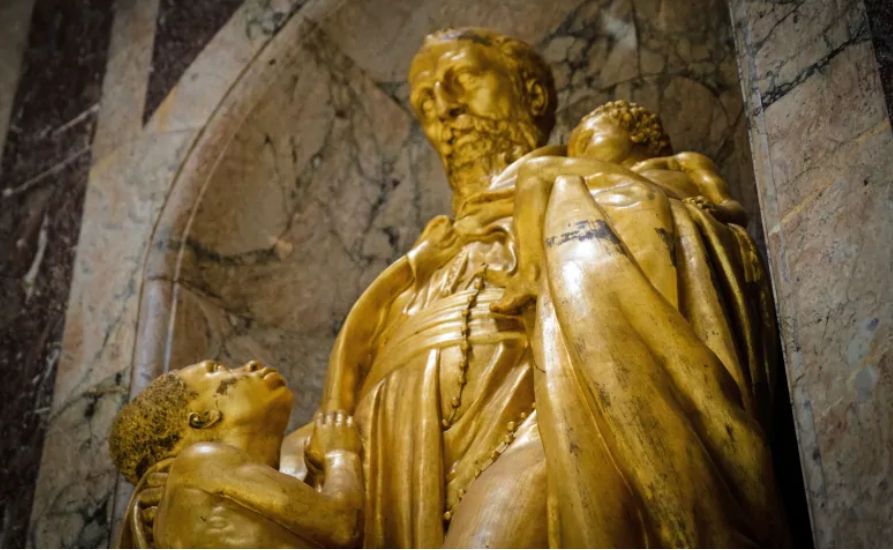
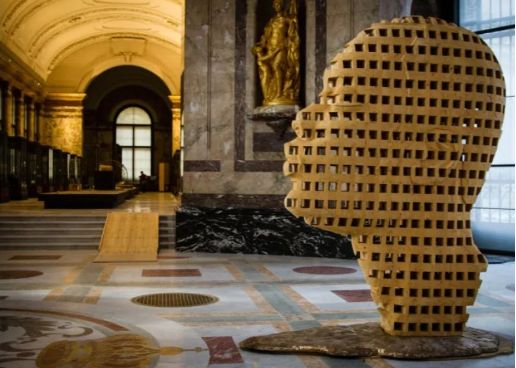
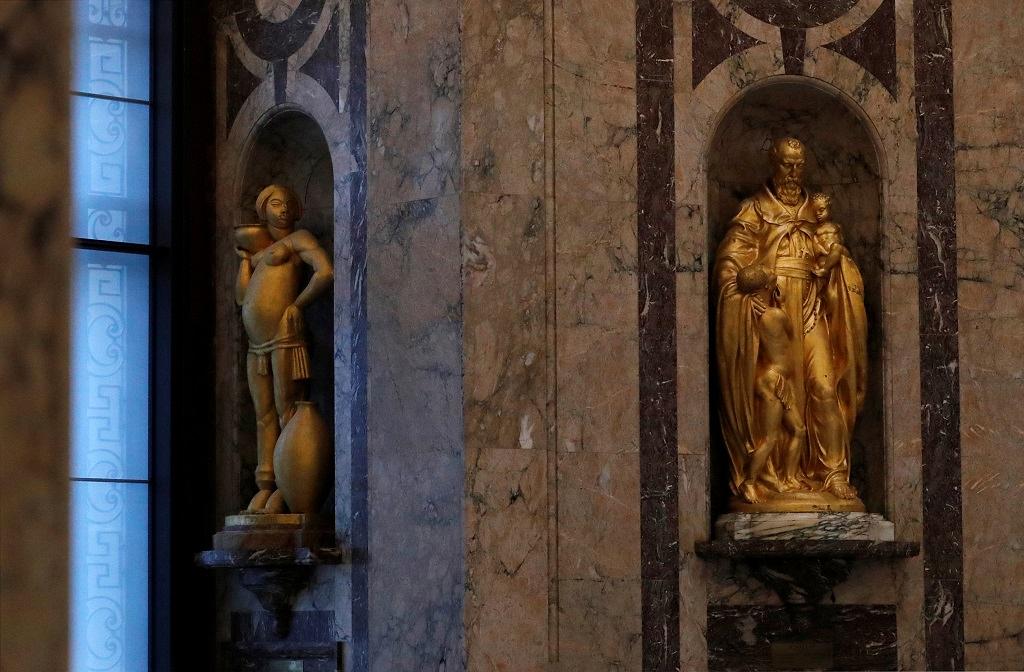
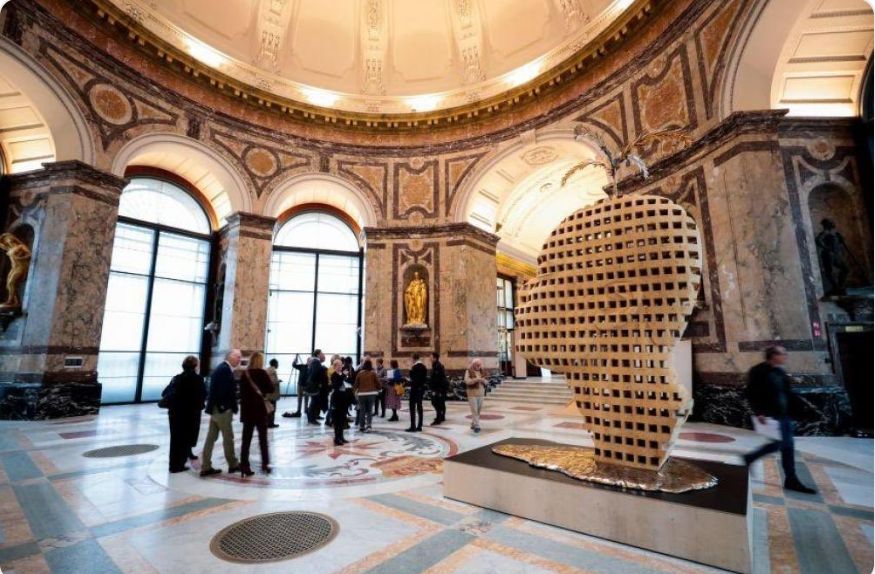
I (E.V.) did visit
the museum myself in 2003, the year an initial renovation proposal was
presented to the press. At that time I was working on a related seminar and had
also posted on my website how Leopold II promoted
his Congo project. That same year I also posted what by now might seem a
somewhat controversial look at the Rwandan Genocide.
The person who
brought me to the museum by private car (as a first-time visitor one will
notice that the Museum is somewhat secluded) had spent his childhood in the
Belgian Congo and just recently has also been interviewed in context of the
Belgian "Children of the Colony" TV series. In fact, I did
communicate with him today (10 Dec.) when I decided to write this article
mentioning to him the "Belgium’s Africa Museum Had a Racist Image. Can It
Change That?" article and he answered, "Thanks Eric I agree with
this and have commented (in a similar vein) about this before."
As Guido Gryseels also said it is an emotional issue for many
Belgians, who
will have had relatives who worked in Congo in one form or another over the
years.
Thus Gryseels expects a "very mixed" reaction to his
institution's attempt to reconcile this past, and that African communities may
say it doesn't go far enough toward decolonialization, that there should be
much more awareness about the violence perpetrated against their people.
On the other hand,
the director told
DW, "a lot of [Belgians] went there with a lot of idealism. Obviously
there's been thousands of doctors who went to Congo who worked in very
difficult conditions, vaccinating children, helping women to deliver, building
hospitals and dispensaries. You can't really say that they were racists on a
negative mission."
We also should not
forget that the now so absent Belgian Royal Family was publicly protesting the
findings of Adam Hochschild's haunting best-seller, King Leopold's Ghost. And
the Belgian
government next denounced a BBC Four documentary with Louis Michel a Member
of the European Parliament and the father of Charles Michel,
the current Prime
Minister of Belgium. saying Leopold was “a true visionary for his time – a hero”.
In fact in 2005 also
director Guido Gryssels himself said that one simply needed to
“contextualize” the “allegations” by Hochschild and debates over the misplaced
use of the term “genocide” in the Leopoldian colonial
past.
Thus the Royal Museum
for Central Africa has long been
accused of complicity in perpetuating the distorted history of the likes of
Charles Michel.
But things started to
change, in 2015 when the Belgian Government wanted to honor King Leopold II the
event now was considered
a “bad idea” by a number of organizations.
In fact we fully know
today that as a result of King Leopold II‟s colonization of the Congo Free
State and then Belgium’s annexation of the Congo from Leopold, the
Congolese were left with little to no ability to successfully rule over
themselves. After a series of revolts, Belgium finally granted the Congo
its independence in 1960. However, when independence came there were less than
30 university graduates in the Congo. Hochschild states, “There were no
Congolese army officers, engineers, agronomists, or physicians.” Thus they had
no people who were specialized in military affairs, construction, farming, or
healthcare which are all vital to any government. Furthermore, Hochschild
notes, “The colony's administration had made few other steps toward a Congo run
by its own people: of some five thousand management-level positions in the
civil service, only three were filled by Africans.” Only three Africans out of
millions in the Congo had administrative experience. This is a dilemma because
it hinders the growth of businesses as there is no one who could lead them.
The policies of King
Leopold II allowed for future rulers like Mobutu and the Kabila’s to dictate
over the Congo and further extract its resources.
Thus King Leopold II,
through his ability to deceitfully acquire the Congo using philanthropic
smokescreens and his ability to institute extensive forced labor resembling
slavery, he set the stage for the Congo’s ethnic, political, and economic
turmoil. His actions helped disband some of the Congo’s most powerful kingdoms
like the Luba, Lunda, and the Kongo. These kingdoms provided stability to a
vast region and maintained an efficient administration that was connected to even
the smallest of villages through councils for provinces, districts, and
chiefdoms. With the annexation of the Congo by Belgium, which was only possible
through Leopold’s previous ownership, they disbanded more tribes and as stated
would cause massive ethnic wars among the many ethnic groups competing for
power in the Congo’s independence of 1960.
Politically, Leopold
ensured that the Congolese would not have a chance at self-rule for over a
century. Belgian rule lasted for almost 60 years and continued the policies of
Leopold. They granted land to concession companies, who all together extracted
billions of dollars worth of resources that were
never paid back. The Congolese were deprived of any positions in the
administration and due to a lack of education would almost be inept at
self-rule from the lack of training. The transition to Mobutu after Belgian
rule also put the Congo in decades of dictatorial rule. Although Joseph Mobutu
or Mobutu Sese Seko was born in the Congo, he was very much a puppet for the
Western powers who assassinated the publicly elected Lumumba in 1961 to put him
there. Then with the Kabila family in power today, it looks like the Congo is
following the same political repression and lack of civil rights and equality
that existed in Leopold’s Congo Free State. The Congo was never given the
chance of having a representative democracy where people could vote for
candidates who in turn would serve their best interests. Instead, due to
Leopold’s rule, the Congo was placed in a quagmire of authoritarian rule and
dictatorships which continue to prevail.
Economically, the
Congo has suffered more than most states. Leopold created a policy of forced
labor and those laborers were paid next to nothing for their hard work. The
Congo was turned into an enclave economy that was solely developed for
extraction of resources. Belgium also made the Congo a plantation economy
demanding huge quantities of crops especially during World War I and the Great
Depression. This, in turn, forced the Congo to take loans from Belgium to pay
for their own resources. Yet, combined with interest, these loans could never
possibly be paid back without a functioning domestic economy. As Leonard and
Strauss mentioned above, with an enclave economy, Leopold, Belgium, Mobutu, nor
the Kabila’s would have to provide for domestic production or social
institutions as the wealth of the people were not in relation to the wealth of
the state. Without an effective job industry, the Congolese could never pay
back the debt inherited by early Belgian rule. Therefore, according to the
dictators, reforms were unnecessary and hence the Congolese continued to be
subjugated by poverty.
It was as recent as
2017 that U.N. Ambassador Nikki Haley on Friday that this authoritarian nation
holds delayed national elections in 2018, saying
continued international backing for a nation that hosts the largest United
Nations peacekeeping mission is at stake.
One could also argue
of course Belgium’s “great forgetting”, as Hochschild terms it, was not always
an accident. In the years before 1908, Leopold instructed the burning of state
archives, telling an aide: “I shall give them my Congo, but they have no right
to know what I have done there”. For much of the rest of the twentieth century,
attempts to investigate
the history of the Congo Free State were fiercely suppressed. Until the 1980s,
Jules Marchal, leading historian and former
Belgian Ambassador, was
prevented from accessing papers held in Foreign Ministry archives, despite
having diplomatic clearance. Others writing on the topic reported receiving
threatening anonymous letters and having their lectures interrupted by former
colonial officers.
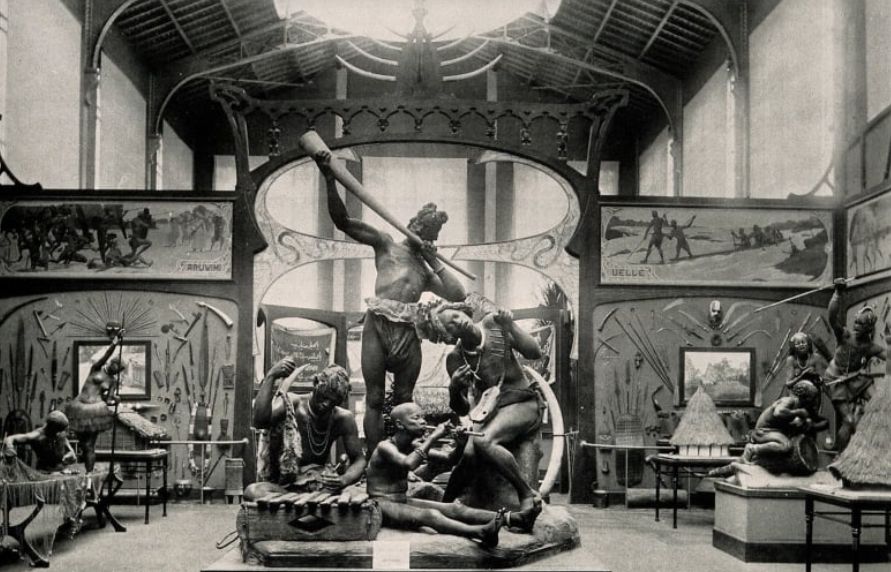
But Guido Gryseels, who has been masterminding the changes, now
insists he will "decolonize" the museum in form and message,
delivering a more honest narrative to the Belgian public. "That the Congo
was not the story of bringing civilization, that it was not a story of
eliminating the slave trade, that it was a story of brutal capitalism, looking
for resources, looking for profits."
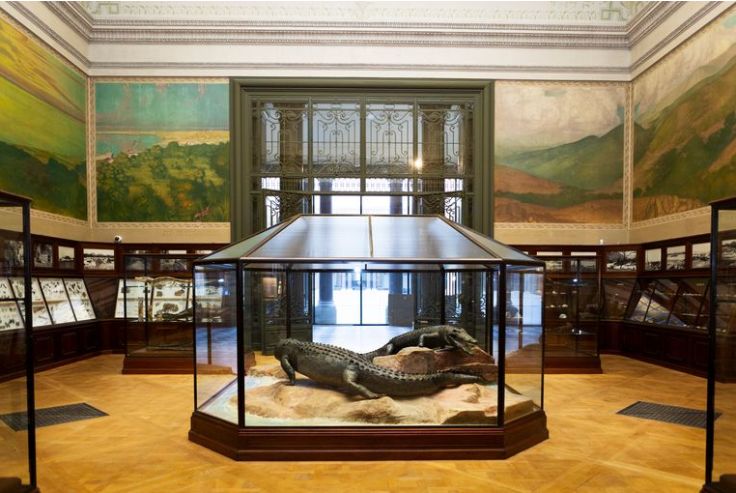
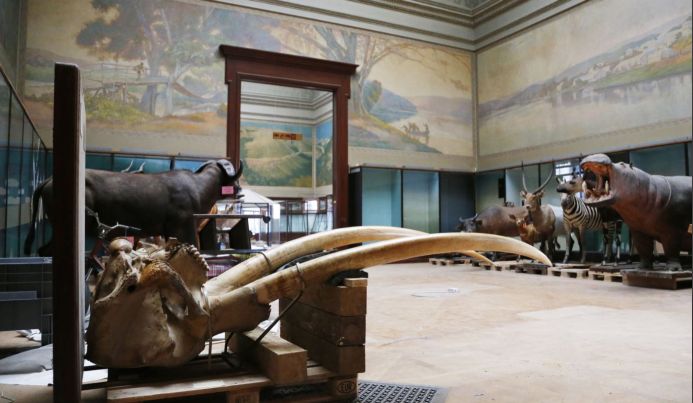
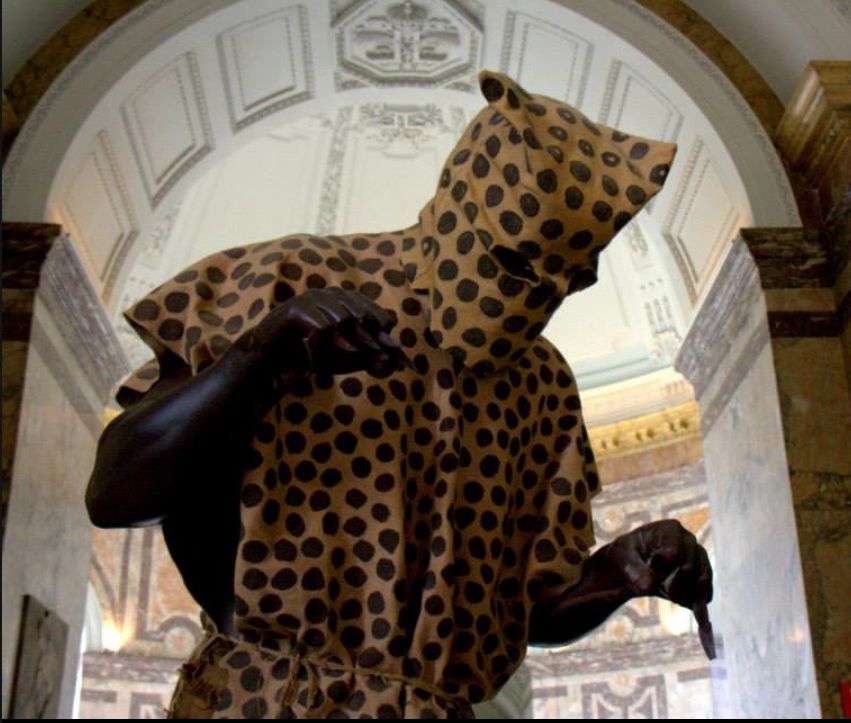
Today problematic images like the above are stored in a barricaded
section without descriptions titled: “A Museum in Motion.”
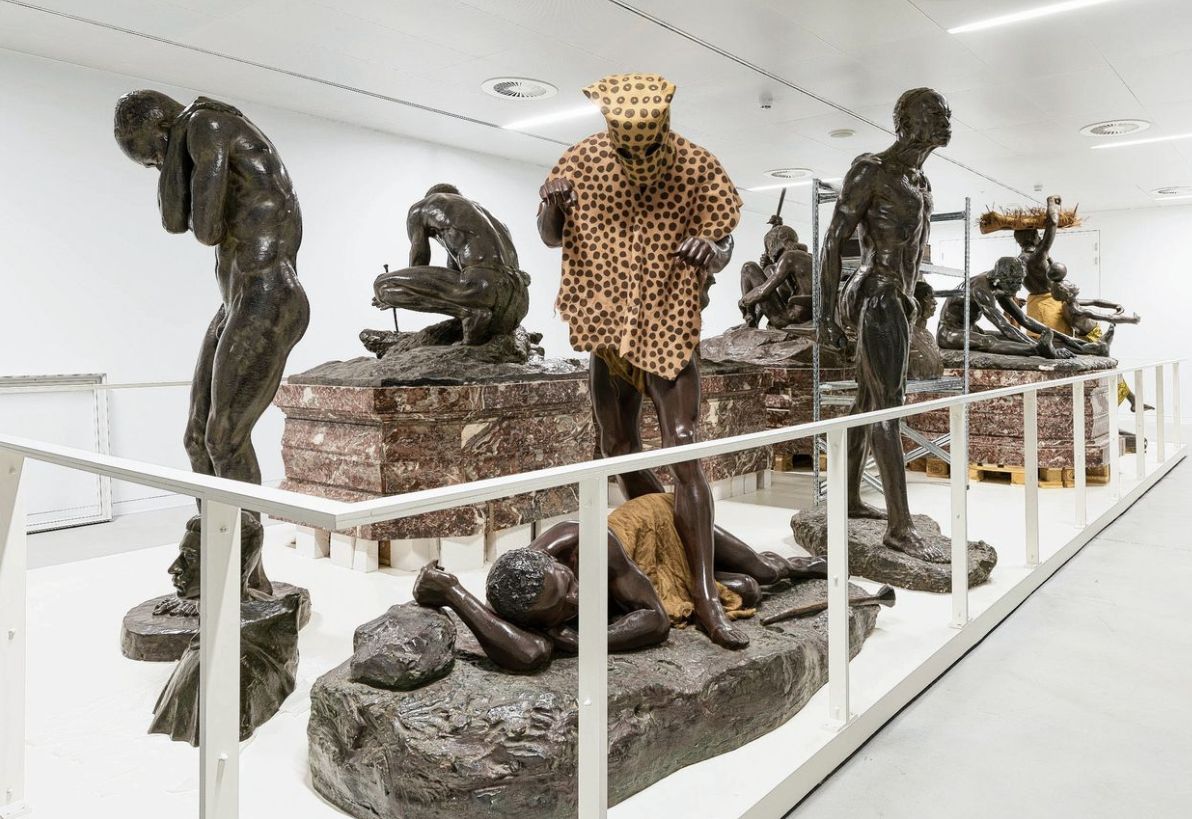
For
updates click homepage here